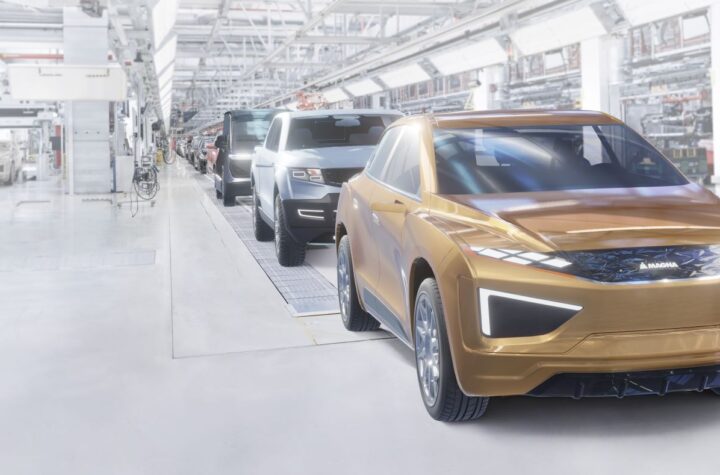
Automakers choose from a wide variety of engine technology.
 |
| BMW’s new 7-Series V-8 (above) features Valvetronic (below), a variable valve system that varies lift steplessly from 0.2 mm to 9.85 mm, eliminating the need for a throttle. |
 |
In the technological semi-dark ages, a healthy pair of overhead valves (OHV) activated through lifters, pushrods, rockers and springs by a camshaft buried deep in the cylinder block used to be pretty much state-of-the-art. This system was simple, cheap, reliable, durable, space efficient and easy to service.
Then automakers in markets where fuel was heavily taxed to discourage consumption — most notably Europe and Japan — decided that overhead camshafts and three or four valves per cylinder were worth the near-doubling of cost and complexity for the fuel efficiency gained. The shorter mechanical path compared to lengthy pushrods provided additional efficiency and valve timing precision, though they made engines taller and tougher to package underhood.
More recently, the relentless pressure to improve both emissions and economy, while simultaneously boosting performance, has led to a new round of technology to further optimize flow and timing. More than just the amounts of fuel/air mixture and exhaust you can move in and out of each cylinder, and the speed at which you can move it, engine enhancement has recently evolved into a complex game of precision control and variation of the timing of valve events to optimize combustion and purging of waste gases.
The Engineering Challenge
A cam lobe is a wonderful thing. Through its carefully designed curvature, as the camshaft rotates in sync with the crankshaft, it provides a specific amount of lift of a valve off its seat and into the cylinder, a specific duration of that lift while gases are flowing in or out, and a rate of change, or acceleration, of opening and closing.
It was once sufficient for engineers to design and tune cam lobes to manage those three factors for intake and exhaust events relative to piston position and each other. Now they need to instantaneously rotate camshafts relative to the crankshaft and each other while precisely controlling timing and duration of fuel injection and, in some cases, simultaneously varying valve lift. It’s all enabled by electronic throttle control and complicated by the need for painstaking programming and calibration of the powertrain controls that make it all happen.
BMW Valvetronic
 |
| The two-stage intake manifold uses uses two intertwined helical elements, rotated relative to each other by a servo motor, to vary the intake path length steplessly between 215 and 607 mm. |
Among the benefits are an impressive 325 hp from 4.4L — 15 percent more than the engine it replaced — plus livelier accelerator response, smoother light load operation and 18 mpg city, 26 highway EPA economy.
“The primary purposes of Valvetronic are reduction in fuel consumption and emissions,” says BMW Technical Service Manager Vlodek Olczak. “You can also increase power and torque, improve the torque curve and improve engine acoustics. Everything is done by optimizing the flow through the intake manifold into the valves and improving filling of the cylinders.
“Compared to conventional valve gear,” Olczak explains, “the major difference is the intermediate lever between the camshaft and the roller finger. There is a spring on one side, which ensures that there is always pressure on the intermediate lever against the camshaft. At the bottom of the intermediate lever is a heel. When the valvetronic motor turns, it activates the lobe on the eccentric shaft, which changes the position of the heel on the intermediate lever. The hydraulic lifter actuates one end of the roller finger, while the other end actuates the valve. When the lever is closer to the camshaft, the heel is pressing farther down on the roller finger, which opens the valve farther.”
The downsides are cost, complexity, serviceability, plus added height of the engine. Besides all the added hardware, Valvetronic requires its own computer interacting with the engine control module, plus premium materials and extremely precise manufacturing and assembly.
“There are many more moving parts,” Olczak says. “They are high quality materials, and the finishing, precision and tolerances in the whole drivetrain are critical to achieve. Testing of the completed heads to ensure equal balance between all the cylinders is complicated and time-consuming. If you have to replace, say, intermediate levers and roller fingers, they are matched and have to be replaced in pairs. This is state-of-the-art, and state-of-the-art comes with a cost, but it is the cost of progress.”
VVT and Variable Intake Manifold
 |
| The mechanism at the heart of GM’s 2-step VVA is a switching roller finger follower driven by cams with two different profiles. |
Two-stage intake manifolds switch between a short air path to maximize volume at high loads and a longer one to increase charge speed and turbulence at low to medium loads. This variable manifold (seen first on BMW sixes) uses two intertwined helical elements, rotated relative to each other by a servomoter, to vary the intake path length steplessly between 215 and 607 mm. Interestingly, the 438-hp 6.0L V-12 version of this engine in BMW’s new $116,000 760Li flagship features Valvetronic and Double VANOS but not the variable intake manifold, and it adds gasoline direct injection (nozzles inside each combustion chamber) to achieve EPA economy of 15 city, 23 highway from a nearly 2.5-ton luxury sedan.
Gasoline Direct Injection
 |
| GM’s Twin-Lift system allows the engine to run on two different cam profiles, yielding 80 to 90 percent of the benefits of a fully flexible valvetrain such as BMW’s Valvetronic at much lower cost. |
“Mitsubishi was first among the Japanese and the biggest promoter of GDI,” says FEV Engineering Vice President Joachim Wolschendorf. “And there’s been a lot of interest in Europe, driven by fuel economy. BMW, Mercedes, Audi and VW brought out engines with GDI…but now some reality has set in. The gain is not as much as they expected, and the aftertreatment is difficult. “To get the biggest gains from GDI, you need to run very lean, 16:1 or 17:1, but then you are running outside the highest efficiency for the conventional three-way catalyst. Direct-injection really requires new aftertreatment systems, which require low-sulfur fuel. BMW runs their GDI at stoicheometric air/fuel ratio (14:1) in their U.S. V-12 engine to be able to use the three-way catalyst without low-sulfur fuel, so they are not realizing all the benefit of GDI.
Cylinder Deactivation
GM is also busy readying cylinder deactivation, or Displacement on Demand (DOD), which will eventually be standard in all its OHV V-8s and V-6s, beginning in late 2004 on ’05 models. This simple, inexpensive system uses hydraulically activated pins to disable the pushrods of alternating cylinders at light loads, shutting down half the cylinders to improve fuel economy eight percent or more, depending on conditions. Cylinder deactivation, a natural for OHV engines, is achievable but far more complex with overhead cams.
Do the Two-Step
Honda uses continuously variable (intake only) camshaft timing and “Lift Electronic Control” in a combination it calls i-VTEC in the 200-hp 2.4L DOHC four that powers its new Acura TSX sedan. With three rockers operating each pair of intake and exhaust valves, i- VTEC varies each valve’s opening lift and duration. At low rpm, the valves follow low-lift, short-duration cam profiles for optimum cylinder filling to boost low-end torque. Above 6,000 rpm, the valves are operated by highlift, long-duration profiles for maximum power. GM’s is developing a simpler take on this idea as an affordable way to do for DOHC 4- valves what DOD does for OHV engines. Called Twin-Lift, this system “allows the engine to run on two different cam profiles,” says Fritz Indra executive director, GM Powertrain. “One is high-profile, which can be higher than it is today; the other is low-profile, around 4-5 mm. Together with two cam phasers (intake and exhaust VVT), you can get 80-90 percent of the benefits of a fully flexible valvetrain such as BMW’s Valvetronic at much lower cost.”
The mechanism is “a switching roller finger follower,” he explains, “with a hydraulically actuated pin. When the pin is out, the follower is one solid piece. When the pin goes in, the follower splits into two sections.” The followers are driven by cams with two different profiles, low in the middle, high on both sides. Importantly, there’s no need for an expensive redesign of the heads, since GM’s recent DOHC 4-valve engines — Northstar, V6 VVT, Ecotech — are relatively new and share similar roller-finger valvetrains. “Another thing is that you can run two different cam profiles for the two inlet valves,” Indra adds. “By opening one inlet valve, say, only one millimeter and the other maybe 5 or 6 mm, this gives you a chance to get a swirl in the combustion chamber for free, because it depends only on the cam profiles.”
Port Deactivation
Another technique to improve efficiency, emissions and idle stability, especially on smaller engines, is the “Twin Port” intake on GM’s latest 1.6L European Opel Astra engine. Using a throttle valve to close off one of two intake ports at low loads, which creates a high swirl level to improve combustion stability, Twin Port can achieve more than 80 percent of the potential of GDI at much lower cost and complexity, GM says.
Electro-Mechanical Valve Train
FEV Engine Technology in Auburn Hills, Mich., has been developing an innovative Electro-Mechanical Valvetrain system for some 15 years. “We have several demonstrator vehicles running with this technology,” Wolschendorf says. It’s not going into production next year or the year after, but if you look a little bit beyond that, it is reasonably close.” The valves are spring-loaded both directions and actuated by two electromagnets, one above, one below. They are opened and closed by varying current to the magnets — at any time, at any speed, to any amount of lift and for any duration.
“With this system, you have all the flexibility you can imagine,” Wolschendorf explains. “You can completely adjust the timing and lift of each valve independently. You can have any number of cylinders running, or not running, and switch from cylinder to cylinder to keep the cylinders warm. You can have cylinders running as normal 4-stroke or 8-stroke. You can switch from 2-valve to 3-valve to 4-valve configuration, depending on where you are on the engine map.
“On the other hand, such complete flexibility can be the engineer’s nightmare, because he has to calibrate all these variables. I’m not sure that we have explored the full potential of this technology yet because of the tremendous amount of variability.”
Variable Compression Ratio
 |  |
| FEV is developing a variable compression engine that moves the crankshaft up or down via eccentric bearings. | |
“What you are seeing around the globe,” GM’s Indra concludes, “is increasing ‘mechanical flexibilization’ of gasoline engines, with a combination of technologies — flexible valvetrains, direct injection, maybe in combination with start/stop systems (mild hybrids), to bring gas engines much closer in fuel economy to diesels. We are trying to get the efficiency of gas engines much closer to diesels, but still at lower cost.”













More Stories
From Gasoline Powered Cars To Electric Vehicles | Electric Moped Bike A Best Alternative
Rubbernecking: A Silly Reason for Car Accidents
Flexible Magna Manufacturing Solutions: The Key to Success in the Automotive Industry